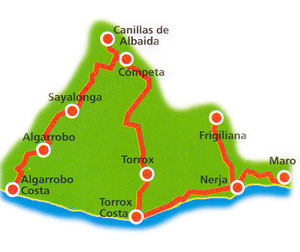This route provides a misture of coastal and inland sights. Once again the combination of the atmosphere of the beaches with the peace and quiet of the countryside, culture and tradition, a cuisine based on fich dishes and tasty products of the mountains.

The coast shows us its past. El Morro de la Mezquitilla, with remains from the Calcolithic era, the Necropolis of Trayamar, with Punic and Phoenician tombs going back to the 10th century BC, both within the Algarrobo municipal area, and the fascinating archaelogical site of el Faro in Torrox- Costa, all take the visitor back to a past where the Mediterranean was the centre of the world.
Algarrobo – Costa and Torrox – Costa house a great deal of the beach tourism of the easternmost area of la Axarquía, but the most highly developed area is undoubtedly in Nerja.
As with Vélez – Málaga, such are the many and varied things to see and get to know, that it is difficult to synthesise in a few lines. Besides the rich archaelogical and monumental patrimony it is home to Cástulo – Malaga Roman Road and the El Salvador Parish Church what most attracts the vositor´s attention in the town is the Balcón de Europa vantage point, built on the remains of the old castle.
A few kilometres from Nerja, Maro completes the area´s cultural and natural heritage with its “Acantilados de Maro” Natural Reserve, the Roman Aquaduct and above all, the Cueva de Nerja. A declared National Monument, this rocky formation of crystaline dolomites over 250.000 years old is surprising in its spectacular beauty and uniqueness. Every year in July this is the setting for tha Cave of Nerja International Festival.
The route inland winds among villages with a marked rural flavour, their common denominator being the steep and narrow streets, bearing witness to their original Arab layout. Intense light, whitewashed walls, flowers and cleanliness are the hallmarks of these villages. This is an area of vineyards: Cómpeta makes a great show of this each month of August during the Noche del Vino, when thousands of people make their way up to its 636 metres to drink, dance and sing.
At the easternmost end of the Sierra and a few kilometres from Nerja, Frigiliana maintains a Morisco- Mudejar centre which has received numerous awards for its excellent state of conservation.


